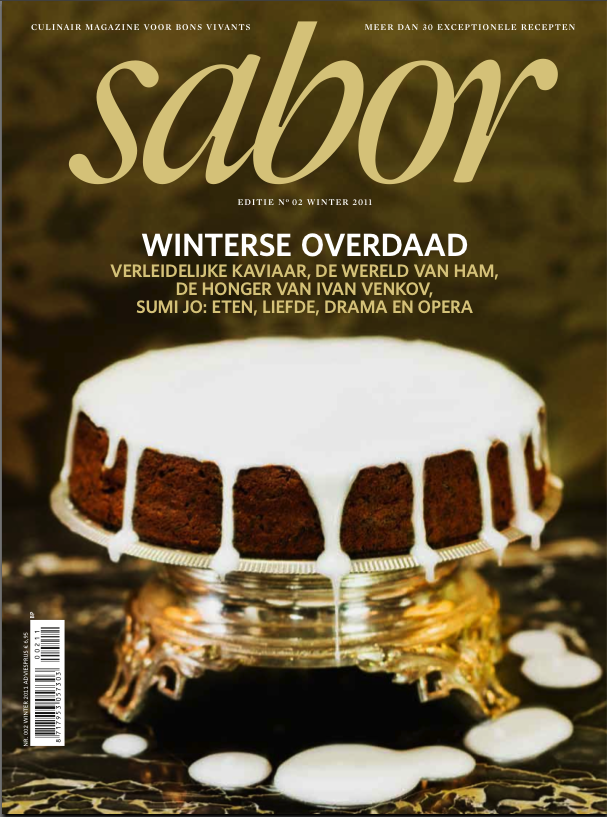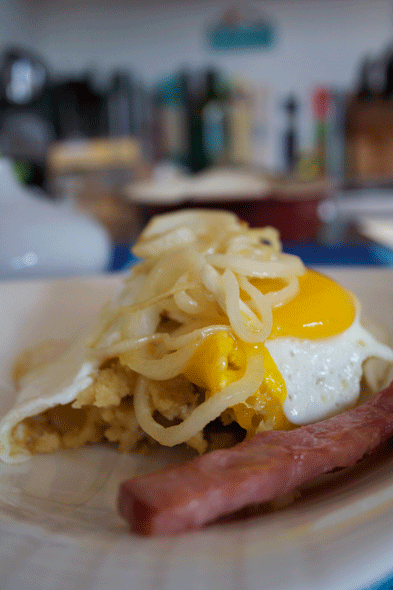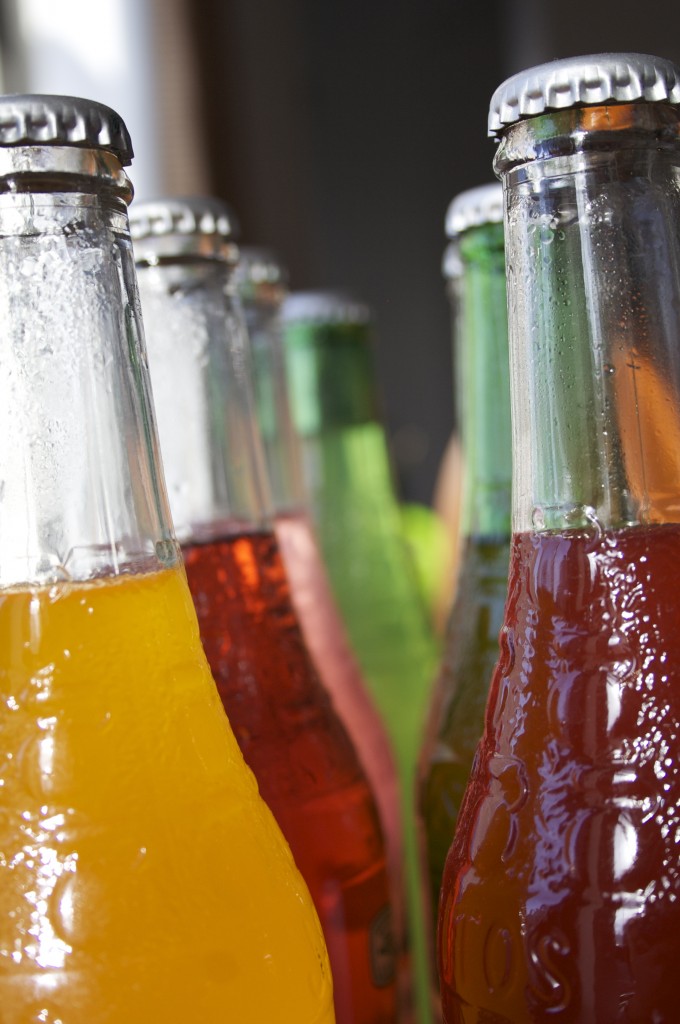Latin America
Latinfoodie Goes to Europe12.12.11
Hello Friends, I’m thrilled to share with you my first international byline! I have just been published in Sabor, a food magazine distributed in the Netherlands. For their Winter 2011 issue, I had the honor of covering Latin American tamales, prepared throughout the Caribbean and Venezuela during the Holidays. The story has been translated to Dutch, but here’s the original story in English. Hope it’s what you need to kick off a wonderful and blessed Holiday season! ¡Felices Fiestas! more »
Easter in a bun04.16.11
Ever since we moved to Clinton, a year and a half ago, we’ve been savoring the perks of living in the heart of the city. We not only walk to work, but to a butcher shop, spice market, flea market and fishmonger all located within a 5-block radius. But one of the most treasured discoveries has been the “Chinese Bun”. Ming Du, formerly known as Ying Du, is a Chinese bakery located on 38th street and 7th Avenue, and a neighborhood goldmine. Some days, when I get my breakfast on the go, a quick stop gives me a glimpse into the early morning buzz of Chinatown. When I place my order at the counter, I always notice a devoted clientele stationed throughout the restaurant, ready to start the day with noodles, hot broth, the daily paper and sweet milk tea.
However, the main reason G and I visit Ming Du are for the assortment of their breakfast pastries. They are puffy, golden spectacles filled with red bean, pineapple, egg cream or onion scallion, making them one of the most affordable breakfasts in the city. A bun plus a small cup of tea usually sets you back about $1.35.
Which brings me to the main point of my story. Lately, I’ve been craving my habichuelas con dulce, that unique Easter dish from the Dominican Republic made from cooking red beans, coconut milk and sweet potato. With the red bean bun from Ming Du, now I can get the sweet and creamy flavors of my habichuela in a slice from the Far East right down the street.
Magnificent Mangú03.09.11
For me, weekends are for sleeping in, seeing friends, catching up on life and most importantly, indulging in the luxury of time. Creating elaborate breakfast dishes is such a treat that I sometimes enjoy the process more than the actual tasting (ahem, NOT). Mangú con huevo, the quintessential breakfast dish from the Dominican Republic is the perfect case in point. Mangú, or mashed green plantains, is made by boiling green plantains and crushing them with olive oil and butter until they’re soft and creamy. In the D.R., mangú is typically served with fried cheese, fried salami (a local sausage), sunny side eggs and avocado. The end result is a feast of textures: the smoothness of the egg yolk balances the density of the plantain, the cheese and salami add a salty crisp and the avocado a cool refuge for your taste buds.
As I prepared this beloved breakfast dish on a recent Saturday, I was reminded of a drive I took with the family through the Dominican countryside, as we made our way to the mountains of Jarabacoa. The morning was rainy and fresh, and we stopped at the breezy roadside restaurant Típico Bonao which lures locals from all over the country to start the day with this dish and an aromatic cup of Dominican coffee. Mangú con huevo brings back this Dominican love, and nourishes the spirit as well as the belly.
Mangú con Huevo Serves 2
2 green plantains
olive oil
butter
salt
red onion
white vinegar
4 eggs
breakfast ham
“queso de hoja” cheese (optional)
avocado (optional)
Chop the ends off each plantain. Make slits throughout the plantain, running the tip of your knife through the length of the fruit. Chop the plantains into 1″ chunks. Fill a pot with water and boil the plantain chunks for about 45 minutes.
While the plantains cook, thinly slice the onion and place the slivers in a bowl with 1 tablespoons of white vinegar, olive oil and salt. Stir these around until the onion gets covered and let it rest.
Check if the plantains are ready by piercing them with a fork. They should be tender when cooked. They will also be easy to peel. Remove their skin and place the chunks in a deep bowl. Pour a 1/4 cup of cooking liquid, a drizzle of olive oil, 1 tablespoon of butter and salt and start to mash with a masher or fork. Work through the pieces, alternating with the liquid, olive oil and butter, until you achieve your desired consistency.
Working quickly, pan fry the onions in a drizzle of olive oil and pour over the mangú. Cover with aluminum foil to keep warm. Next toss the ham, and fry the eggs sunny side up, on a non-stick pan. You can also deep fry the queso de hoja for an authentic latin kick and slice up some avocados on the side. Serve the mangú with the onions, eggs and ham. Eat immediately!
It’s Ceviche Time!11.22.10
It was time for Sunday supper in NYC.
The seafood had been chilling in the fridge, soaking up the flavors of a clear, citrus broth. This was my first attempt at preparing ceviche, the classic dish of cured seafood from the kitchens of Peru and Ecuador, and judging from the delicate flavors and textures it yielded, it would definitely not be my last. I caught the last wave of local tomatoes, dicing their bright red flesh and piling them over the succulent seafood that had been marinating for a couple of hours. On top of those juicy cubes, I added crunchy bits of green pepper, finely chopped slivers of white onion, and fragrant cilantro and parsley that turned out to look a lot like kitchen confetti.
We laid out small bowls throughout the dining table, each one filled with thinly sliced plantains, airy popcorn and chunks of crusty French bread. All these garnishes would create a symphony of textures to accompany the cool, clean dish. We bit into the plump pink shrimp, nibbled delicately on the silky mussels and popped the morsels of scallops and miniature clams into our mouths. We sipped on cold white wine, while talking and laughing.
That afternoon I had visited the food markets of the Upper West Side, and after getting home, I turned to The South American Table cookbook for guidance. The result was a light and flavorful meal: the orange and mustard in the marinade gave the seafood a sweet and tangy note, the toppings gave it crunch and a lemony freshness. The different garnishes added an interactive component that was a hit.
This weekend, a hint of Spring was in the air. It was time to venture into something new.
Shellfish Ceviche Serves 6 (I served it as a meal, but you can also make it as an appetizer at your next dinner party)
4 cups water
1 scallion, sliced
1 lb. medium shrimp, peeled and deveined
½ lb. bay scallops
¼ cup dry white wine
1 lb. mussels, scrubbed and deveined
16 baby clams
MARINADE
1/3 cup lemon juice
1/3 cup lime juice
2/3 cup orange juice
½ cup chicken broth
1 tablespoon extra virgin olive oil
1 teaspoon Dijon mustard
1 teaspoon Worcestershire sauce
½ teaspoon sugar
½ teaspoon salt
¼ teaspoon black pepper
Hot sauce
GARNISHES
1 medium tomato, peeled, seeded and finely chopped
1 small green bell pepper, seeded and finely chopped
1 small onion, finely chopped, rinsed with hot water and drained
2 tablespoons fresh cilantro
2 tablespoons fresh parsley
SIDE DISHES
Popcorn, plantain chips (chifles), French bread, ripe avocado
INSTRUCTIONS
In a large saucepan, bring water and scallions to a boil, reduce heat and simmer for 5 minutes. Add shrimp, remove from heat and let stand for a few seconds until the shrimp turn pink. Remove shrimp and rinse under cold water.
Add scallops to the cooking liquid and bring back to boil. Remove from heat, cover and let stand for 3 minutes. Once scallops are cooked through (their center should be white), drain and rinse under cold water.
Place wine, mussels and clams in large skillet and bring to boil. Cover and continue to boil until shells are open, 3 to 5 minutes. Remove clams ad mussels from their shells.
Make marinade by combining all the ingredients in a large glass or ceramic bowl. Stir in shrimp, scallops, mussels and clams. Mix well, cover with plastic wrap and refrigerate for at least 2 hours.
Before serving, taste for salt, sugar and spice. Serve with garnishes and side dishes.
Bottled Jewels10.31.10
Did you know that there are soft drinks produced all over Latin America, and that you can get a taste of a country’s local flavor just by flipping open one of these bottles? In the Dominican Republic, for example, two of the most popular drinks are Merengue and Refresco Rojo, and are available at Dominican restaurants and bodegas around NYC. In Peru, the local palate lusts for Inca Cola, Cola Real and Chicha Morada. I know, I know, when the temperature starts to drop, it’s more fitting to talk about chocolate caliente and atole? But even though the city seems to have changed from green to fall yellow overnight, my memories of summer are still alive.
I was walking to work one day when I stepped into my corner deli to pick up a bottle of water and some flowers for the week. As I paced through the store browsing the cold drinks stocking the fridge something surprised me. An entire shelf was stocked with a line of the quintessential Mexican soft drink Jarritos. Captivated by the bejeweled bottles, I stared at the luminous rainbow of flavors: tamarind, pineapple, jamaica, mandarin, grapefruit, lime.
Not long ago, lime soda became my summer drink of choice. Along with boogie boarding Saturdays. G and I would wake up, pack PBJ’s and rush out of the house to squeeze every moment of our long warm days, returning time and time again to our favorite spot on the Jersey Shore. After an invigorating day of playing with the waves, we would drive home when the last hint of light covered the sky, picking up burritos at our favorite tex-mex joint in Hell’s Kitchen. With salt on my skin and leftover sand between my toes, I would order a bottle of the lime green, psychedelic-looking soda, straight out of the pages of Dr. Seuss.






Food For Thought